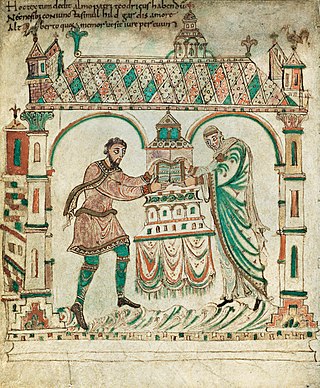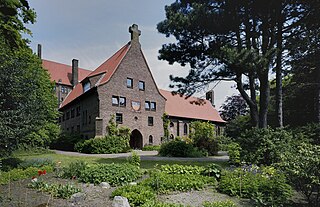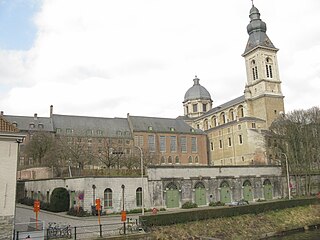Arnulf is a masculine German given name. It is composed of the Germanic elements arn "eagle" and ulf "wolf". The -ulf, -olf suffix was an extremely frequent element in Germanic onomastics and from an early time was perceived as a mere suffix forming given names. Similarly, the suffix -wald, -ald, -old, originally from wald "rule, power" underwent semantic weakening. Therefore, the name Arnulf and Arnold were often conflated in early medieval records, as is the case with bishop Arnulf of Metz, especially as the final consonant came to be dropped (Arnoul).

Arnulf I, called "the Great", was the first Count of Flanders.

Robert I, known as Robert the Frisian, was count of Flanders from 1071 until his death in 1093. He was a son of Baldwin V, Count of Flanders, and the younger brother of Baldwin VI, Count of Flanders. He usurped the countship after defeating his nephew Arnulf III and his allies, which included King Philip I of France, Count Eustace of Boulogne and the counts of Saint-Pol and Ardres at the Battle of Cassel. He subsequently made peace with Philip, who became his stepson-in-law, but remained hostile to his sister Matilda and her husband William the Conqueror, who was king of England and duke of Normandy.

The County of Holland was a state of the Holy Roman Empire and from 1433 part of the Burgundian Netherlands, from 1482 part of the Habsburg Netherlands and from 1581 onward the leading province of the Dutch Republic, of which it remained a part until the Batavian Revolution in 1795. The territory of the County of Holland corresponds roughly with the current provinces of North Holland and South Holland in the Netherlands.

Dirk V was Count of Holland from 1061 to 1091.
Dirk VI was Count of Holland between 1121 and 1157, at first, during his minority, under the regency of his mother Petronilla. He was the son of Count Floris II. After his death he was succeeded by his eldest son Floris III. He married Sofie of Salm, Countess of Rheineck and Bentheim. She was heiress of Bentheim, which she ruled together with her husband and which was inherited by the couple's second son Otto after his parents' death.

Adalbert of Egmond was a Northumbrian Anglo-Saxon missionary. He was one of Willibrord's companions in preaching the gospel in Holland and Frisia.
Dirk III was the count with jurisdiction over what would become the county of Holland, often referred to in this period as "West Frisia", from 993 to 27 May 1039. Until 1005, this was under regency of his mother. It is thought that Dirk III went on pilgrimage to the Holy Land around 1030, hence his nickname of Hierosolymita.
Richilde, Countess of Mons and Hainaut, was a ruling countess of Hainaut from c. 1050 until 1076, in co-regency with her husband Baldwin VI of Flanders and then her son Baldwin II of Hainaut. She was also countess of Flanders by marriage to Baldwin VI between from 1067 to 1070. She ruled Flanders as regent during the minority of her son Arnulf III in 1070–1071.
Adele of Vermandois was both a Carolingian as well as a Robertian Frankish noblewoman who was the Countess of Flanders by marriage (934–960).
Adela of France, known also as Adela the Holy or Adela of Messines;, was, by marriage, Duchess of Normandy, and Countess of Flanders (1035–1067).
Dirk II or Theoderic II was a count in West Frisia, and ancestor of the counts of Holland. He was the son and heir of Dirk I and his wife Geva.
Arnulf, also known as Arnoud or Arnold, succeeded his father in 988 as Count of Frisia, which by around AD 1100 would come to be referred to as the county of Holland. He was born in 951 in Ghent and because of this he is also known as Arnulf of Ghent. Arnulf was the son of Dirk II, Count of Holland and Hildegard of Flanders. He was named after his maternal grandfather.
Lutgardis of Luxembourg, also known as Liutgardis, Liutgarde and Lutgard, was a countess consort of Holland by marriage to Arnulf, Count of Holland. She was the regent of Holland from 993 until 1005 during the minority of her son Dirk III of Holland.

The Egmond Gospels is a 9th-century Gospel Book written in Latin and accompanied by illustrations. It is named after Egmond Abbey in what is now the Netherlands, to which it was given by Dirk II and his wife Hildegard, and where it remained for six centuries. It is most famous for being the earliest surviving manuscript showing scenes with Dutch people and buildings, and represents one of the oldest surviving Christian art treasures from the Netherlands. The manuscript has been owned by the Royal Library of the Netherlands since 1830.

Egmond Abbey or St. Adalbert's Abbey is a Benedictine monastery of the Congregation of the Annunciation, situated in Egmond-Binnen, in the municipality of Bergen, in the Dutch province of North Holland. Founded in 920-925, and destroyed during the Reformation, it was re-founded in 1935 as the present Sint-Adelbertabdij, in the Diocese of Haarlem.

Adelaide I, a member of the royal Ottonian dynasty was the second Princess-abbess of Quedlinburg from 999, and Abbess of Gernrode from 1014, and Abbess of Gandersheim from 1039 until her death, as well as a highly influential kingmaker of medieval Germany.
Sophia of Rheineck, also known as Sophie of Salm, Countess of Bentheim was a ruling suo jure Countess of Bentheim between 1150 and 1176. She was also countess consort of Holland by marriage to Dirk VI, Count of Holland, who was her co-ruler jure uxoris in the County of Bentheim.

Petronilla of Lorraine was Countess of Holland by marriage to Floris II, Count of Holland, and regent of the County of Holland during the minority of her son Dirk VI in 1121–1129. She was a daughter of Theodoric II, Duke of Lorraine and Hedwig of Formbach.

Saint Peter's Abbey is a former Benedictine abbey in Ghent, Belgium, now a museum and exhibition centre.










